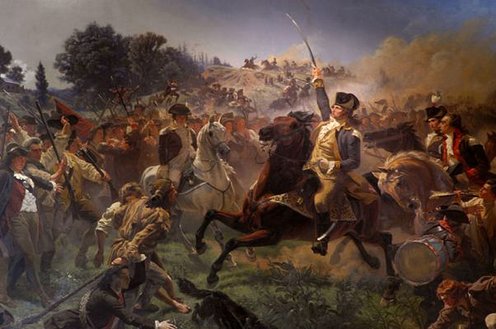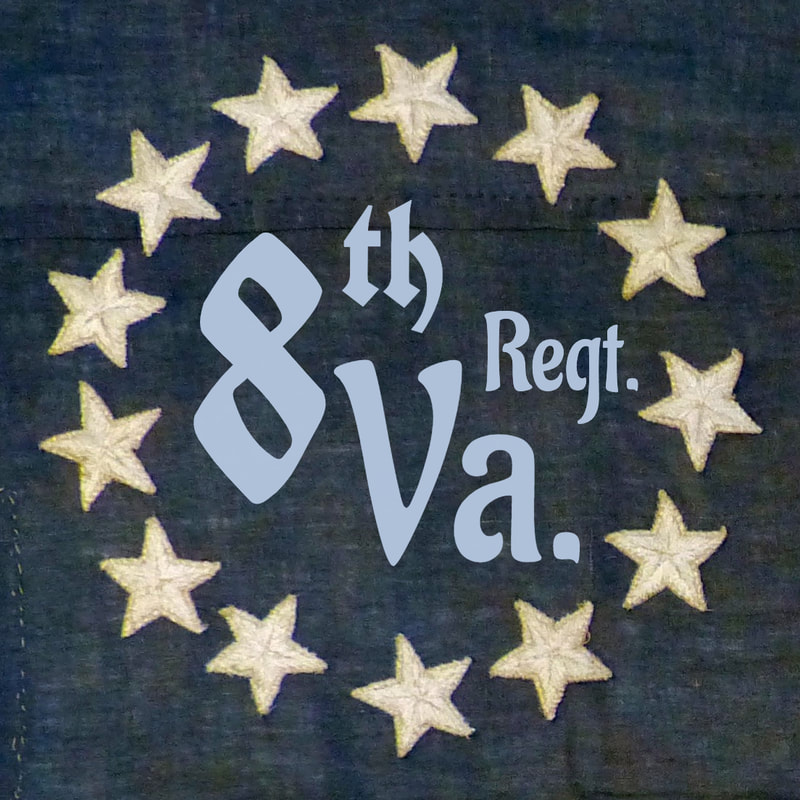 "Washington Rallying the Troops at Monmouth," by Emanuel Leutze--the same artist who painted the famous depiction of Washington crossing the Delaware. "Washington Rallying the Troops at Monmouth," by Emanuel Leutze--the same artist who painted the famous depiction of Washington crossing the Delaware. The Battle of Monmouth Courthouse (June 28, 1778), was the last engagement for the 8th Virginia Regiment in the war. It was fought exactly two years after the 8th Virginia's first real battle at Sullivan's Island, South Carolina. Very few of the original enlistees were still in the regiment at Monmouth. Aside from deaths from disease and battle, all of the original enlistments from 1776 expired during the Valley Forge Encampment. Some of the original officers still remained, however. Some of the original recruits had also reenlisted. Still, the numbers were not enough for a regiment. This was true to varying extents for all the Virginia regiments. Shortly before Monmouth, the 4th, 8th, and 12th Virginia regiments were merged into a unit referred to as the "4th-8th-12th Regiment" under the command of Col. James Wood of the 12th. The three regiments had served together for more than a year in Gen. Charles Scott's brigade, and continued under him. (Grayson's and Patton's "additional" regiments were also in the brigade.) 8th Virginia Colonel Abraham Bowman, who had less seniority than Wood, continued serving for the time being. On the approach to Monmouth, General Scott was put in charge of a detachment annoying the British flank, so Colonel William Grayson took command of the brigade. They led the approach and were in the center of the line during the morning engagement under Maj. Gen. Charles Lee. They were attached to Gen. Anthony Wayne in the afternoon. The was the last battle for the storied 8th Virginia, a unit that first began as a Virginia provincial regiment led by a pastor and loyal (technically, at least) to the King. The Virginia legislature had intended it to be a German (or German-led) unit and commissioned German field officers for it (Col. Muhlenberg, Lt. Col. Bowman, and Maj. Helphinstine). It recruited men of other ethnicities, however, and was never as German as originally envisioned. Some of the men, commissioned and enlisted, continued to fight on to the end of the war. In September, the regiment merged with the 4th Virginia under the latter's number. Colonel Wood's 12th Virginia became the "new" 8th Virginia. Col. John Neville of the 4th remained in command. 8th Virginia Col. Abraham Bowman, who was junior in seniority to both Wood and Neville, was released as a "supernumerary" officer. (After reporting to Gov. Patrick Henry he returned home and then moved to Kentucky.) In 1779, the consolidated 4th was provisionally merged with the 3rd Virginia and known for a time as the "3rd and 4th Virginia Regiment." Lastly, the handful who remained were included in the 2nd Virginia "brigade" sent to reinforce General Benjamin Lincoln at Charleston, South Carolina, in 1780. Some of them were under the command of Captain Abraham Kirkpatrick, who had begun the war as a lieutenant in William Croghan's Pittsburgh company of the 8th Virginia. Croghan, now a major, was also at Charleston. All of them were taken prisoner when Lincoln surrendered on May 12, 1780. Brigadier General Peter Muhlenberg (the regiment's original colonel) and Lt. Colonel William Darke (one of the regiment's original captains) were both at Yorktown. They may be the only men of the original 8th Virginia who served at Yorktown as members of the Continental Army. Private Bean Smallwood, an original 8th Virginia recruit in Captain Berry's company, was at Yorktown as a militiaman. Here is an excellent overview of the Battle of Monmouth. (Updated 12/12/19)
2 Comments
|
Gabriel Nevilleis researching the history of the Revolutionary War's 8th Virginia Regiment. Its ten companies formed near the frontier, from the Cumberland Gap to Pittsburgh. Categories
All
Archives
June 2024
© 2015-2022 Gabriel Neville
|

 RSS Feed
RSS Feed